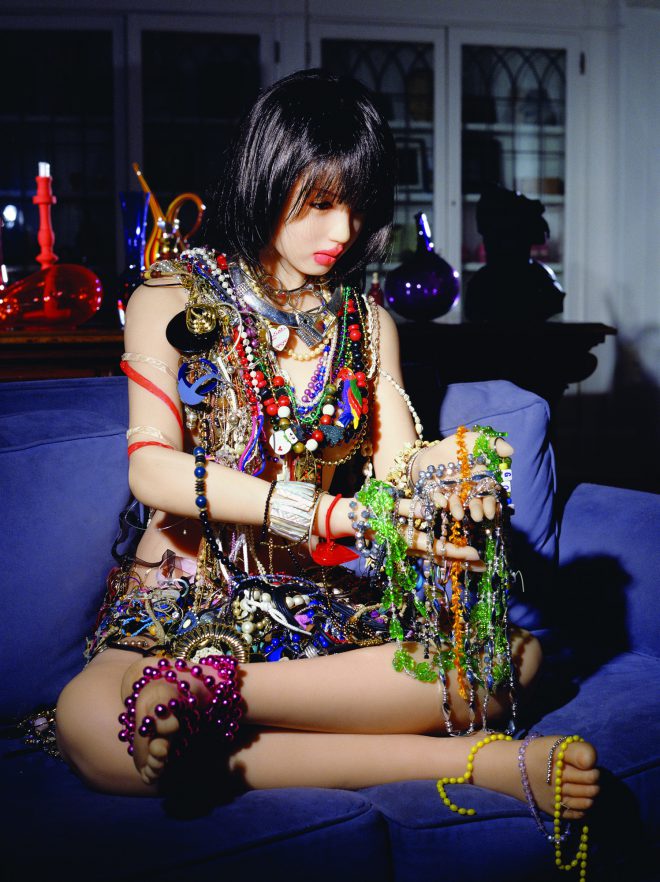The Uncanny Effigy and Celebrity Identity: Laurie Simmons, Kanye West, and Taylor Swift
Lauren Scarpello wonders how we can use the ongoing feud between Taylor Swift and Kanye West to look at art history.

Laurie Simmons, The Love Doll/Day 22 (20 Pounds of Jewelry), 2010. Courtesy the artist and Salon 94, New York.
I saw Laurie Simmons’ “Two Boys and the Love Doll,” when it made its Midwestern debut at the Contemporary Art Museum St. Louis in 2015. The exhibition paired two separate bodies of work—the artist’s large-scale photographs of “male” CPR dummies and those featuring a high-end, latex “female” love doll.
For the latter, created from 2009 to 2011, Simmons ordered a latex love doll from Japan and created a voyeuristic photographic journey personifying the doll in elaborately staged mises en scène. The series chronicles tender and introspective moments “in the life” of the doll—she takes a walk in a winter parka through freshly fallen snow; she lies in a bubble bath, breasts unabashedly exposed; she even sits nude on a sofa adorned in a treasure trove of Mardi Gras beads. Within a culture of carefully constructed Instagram feeds, Simmons performs a bait-and-switch where the moments are “real”—and the “person” is not.
I found myself recalling Simmons’ images a month ago, while wading through the online subterfuge of the on-again, off-again rivalry between Taylor Swift and Kanye West. Celebrities are effigies by proxy—stand-ins for our desires and failings—and the stories they create that we follow on our screens are just as fabricated as Simmons’ narratives. As the story goes, West writes a lyric about Swift in his song “Famous”: “I made that bitch famous.” Swift insists it’s an attack. West’s equally famous wife, Kim Kardashian West, releases an audio recording of the two music moguls on the phone. Turns out, Swift not only sanctioned the lyric, but acknowledged that it would be a point of interest for the press. Therefore, her playing the role of the victim was nothing more than a PR stunt, throwing West under the proverbial bus.
Just weeks before the revelation, outrage surfaced concerning the video for the song, which featured a twisted nude wax effigy of Swift in bed with West among other likenesses of certain volatile celebrities. West claimed it was a nod to Vincent Desiderio and a critique on how celebrities are exploited. However, many had a very guttural reaction to it, saying he did exactly that—exploit.
Most of us remember when Swift, still a teenager, received her 2009 MTV Video Music Award for Best Female Video, when West interjected and proclaimed that Beyoncé was robbed and should have won the award—with Swift standing in meek and startled silence. That move firmly cemented West’s persona of “pompous blowhard” and also firmly cemented Swift’s persona as “innocent sweetheart.”
Fast forward and it’s possible to look at West’s use of effigies within the context of postmodern art and societal critique—in the vein of Simmons and other derivative artists such as Sandra Hoyn. Effigies are tools that present a very clear metaphor. West’s media persona is linked to Swift’s media persona—therein their exploitation is an intimate and shared experience—they are literally and metaphorically in bed together.
Artist Mike Kelley, who rose to fame in the early 1990s and was a contemporary of none other than Carroll Dunham—Simmons’ husband—and who also received commercial success by constructing and selling handmade dolls and stuffed animals, offered some sagacious words on artistic identity in an interview with Ralph Rugoff in 1991 that can be applied as we contemplate the cultural production of both West and Simmons, effigies and their metaphors, images and their depths. Kelley said, “The artist’s social position may be one of irresponsibility, but that doesn’t mean he actually is irresponsible. That’s one of the complexities of art production. The surface meaning is often not its deep meaning.”



